For many people living in remote areas, connecting to the mains grid is not an option. Therefore, they must produce their own power.
In the past, many have resorted to petrol or diesel generators, but these are both noisy, maintenance intensive, and environmentally damaging. In more recent years, other cleaner forms of power generation have become available.
Arguably the most well known energy source is solar power, though other forms, such as wind and water power, are also becoming more common. Unlike fossil fuel-powered petrol or diesel generators, these forms of energy production are known as renewable energy, because they will continue to be available as long as the sun and Earth still exist.
How Does Off Grid Energy Work?
Power is generated by solar panels, wind turbines, or whatever, and is fed into a bank of batteries to be stored for use when required. The power can then be used directly from the batteries or passed via an inverter for use with normal mains appliances.
However, it is not always realistic to use all of the appliances that a mains-connected house might use. Because of the cost of buying extra solar panels, wind turbines, or a larger inverter, using power-hungry appliances like electric frypans, hairdryers, and fan heaters are best avoided or minimized. Paying a little more for an energy-efficient appliance can save a lot of money on generating equipment.
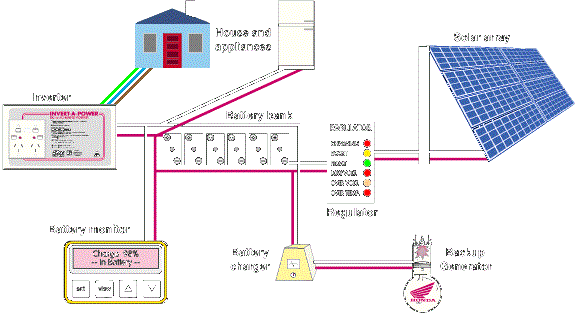
Purpose of This Guide
Rural development is greatly enhanced by the availability of decent lighting, pumping, refrigeration, and audio-visual/communication tools. There is a wide variety of equipment available to meet these needs. However, matching pumps, fridges, lights and other appliances with appropriate power sources is not always easy or straightforward. Making the wrong choice of appliance or power system can be expensive, time-consuming, or even fatal to the success of your business or community development activity. It is therefore critical that planners and purchasers of off-grid appliances – and the energy systems that power them – choose cost-effective and technically viable alternatives.
“Off-grid” means that you are not connected to an electricity grid or network. This is fairly rare in Europe or North America (limited to camping areas, very isolated sites, etc.). However, it is very common in rural areas and many near-urban (peri-urban) areas of the developing world where electricity companies have been unable to connect domestic, commercial, industrial, and institutional consumers. The main thrust of this workbook is to provide “off-grid solutions.”
This guide is designed to help those who require modern energy-consuming equipment in off-grid areas and who must select appropriate power equipment. Particularly, it is aimed at:
- Decision makers in rural areas not served by grid electricity
- Decision makers and technical staff supporting communities in remote or rural areas
- Those who are considering solar electric (PV) systems for their power requirements
This guide is of use to staff and planners of rural located clinics, schools, water pumping sites, homes or camps, aid projects, commercial sites (e.g., tourism, agriculture, etc.), and institutions. It addresses possible options for powering four general categories of appliances:
Lighting
Pumping
Cooling/refrigeration/freezing
Audio-visual
This guide outlines viable options in equipment selection, infrastructure support required, and technology costs and benefits.
This guide also provides signposts to help you make decisions. There is a wide range of information available from renewable energy technology suppliers and support institutions. Once you know what you want, be it a fridge, a lighting system, a television and video player, a pump, or a combination of the three, you should read the particular section in this guidebook for basic information.

It is hoped that each section provides enough information to point you in the direction of the help you need. To effectively use this, you should take advantage of the supplier contacts, websites, further readings, and links listed in each section. You have a wide range of technical options – please consult the resources and dealers listed in this guide for exact advice.
The “Energy Ladder”
We all use energy in various forms and amounts. The most basic forms of energy have been used by humans for eons. Heat has been provided by burning wood and other biomass since time immemorial. Light has been provided by oil lamps and candles for thousands of years. Pumping has been provided by humans and animals for thousands of years, and by the wind for a thousand years. We have been moving “up the energy ladder” with increasing speed over the past thousand years, particularly the past hundred years and the past several decades.
One hundred years ago we began to use kerosene from petroleum for our lighting, along with gas. Over fifty years ago we were using kerosene and gas for refrigeration and freezing. We began to use electricity for lighting, refrigeration, cooling, pumping, and a variety of other uses within the past one hundred years. We began to store electricity in batteries early in the electricity age.
Today, off-grid applications in rural areas in many parts of the world provide a mirror of the energy ladder. In many parts of the developing world, people are at the “bottom” of the ladder, using wood and candles. Increasingly, though, people are moving up the ladder. Dry cell batteries (1.5 V) are used in flashlights, radios, and radio cassettes.
Increasing numbers of people without access to the grid are now using 12 V lead-acid batteries (car, truck, and tractor batteries) for lighting, televisions, and other household appliances. Thousands, perhaps millions, of people in the developing world are now using photovoltaic/PV modules to generate 12 V, 48 V and higher both to drive appliances and to store in batteries for using appliances when the sun is not shining.
Others are using small wind turbines to provide electricity and to charge batteries. Large numbers of people are also using petrol, diesel, and kerosene generating sets to provide even more energy to meet their needs. They are using hybrids of these systems, combining wind, batteries, and gensets.
Whatever the source, the number of off-grid applications and solutions is growing. The complexity of systems and solutions is also growing.
The Role of PV
This guide highlights the particular role of photovoltaic (PV) power in remote and rural power applications. Photovoltaic devices convert solar energy directly into electricity for use in a variety of applications. PV costs are coming down, and the range of viable and cost-effective applications is increasing.
PV technology can supply basic increments of electricity in off-grid rural areas. With many thousands of applications already working, often under the most arduous conditions, the technology has been thoroughly tested. Although further significant technical advances are in prospect, the existing level of PV development is more than adequate to provide a reliable basic supply of electricity for individual and community uses.
The 4 applications covered in this guide can often be powered by PV systems. PV systems are a renewable, environmentally safe, reliable, and increasingly cost-effective technology for generating electricity to meet the small energy demands.
However, PV power is not always the ideal solution for rural power demands. In general, PV is inappropriate for loads over 5 kWh per day. For PV systems, and all other renewable energy systems, a competent person should be used to design the system.
| Situations that favor PV | Situations where PV is not appropriate |
| Small energy demand
Less than 5 kWh per day | When heat is required
(cookers, sterilizers, etc should not use PV) |
| Good solar radiation | When loads will be increased |
| In very remote locations | When daily loads are above 5 kWh/day
(large electric systems) |
| When loads are steady | When loads have a high surge voltage
(X-ray machines, photocopiers, etc.) |
| Good security
PV modules can be stolen |
Categorizing Your Energy Needs
When selecting your power system, you need to make several key decisions about the type of system required. These decisions will affect the overall design of your system. Equipment dealers and reading resources listed in this book will be able to assist you to make these decisions.
Decision 1: One Central Energy System or Many Isolated Energy Systems/Appliances?
Before choosing appliances in remote areas, you should first consider the alternatives available to power the device. In some cases, it may be preferable to obtain a “self-powered” appliance (e.g., refrigerator or lantern). In others, it may be preferable to design an energy system that powers a number of appliances.
The larger the institution, the more likely it is that you will need an integrated system. Pumping and refrigeration often are done as isolated energy systems, while lighting and audio/video appliances are best integrated into an electric system.
Decision 2: Electricity or non-electric power sources?
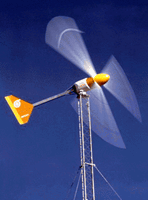
In most situations, it is preferable to have access to electricity – especially when you have a wide variety of equipment to power. You can run lights and fridges with kerosene, gas, or LPG, and you can run water pumps with wind or hydropower directly.
In some locations, this may actually be preferable, and you should consult the relevant sections for more information. However, audiovisuals and high quality lighting will always require electricity. At an early stage, you should choose whether you require an integrated electric power system, or whether you want to run lights, pumps, and fridges from non-electric sources.
Decision 3: How much electric power do you need?
You will need to estimate daily energy requirements for all electric appliances you have and those you plan to obtain. To do this:
- First total the energy ratings (in watts or kilowatts) and daily/weekly use (in hours) of individual appliances
- Then use the above information to estimate daily/weekly energy demand (in kilowatt hours or watt hours) of all appliances.
The better your energy consumption estimates are, the easier it is for suppliers to recommend appropriate solutions. It is important to consider how your energy needs will change in the future (expansion of facilities, upgrading of equipment, connection to electricity grid, etc.).
Decision 4: What are your power source options?
Once you have calculated how much power you need, and whether you want a central energy system or many isolated ones, you need to identify your power source options. It is best to rule out those that absolutely cannot be used and decide between several options. Often, the final choice will be dictated by economic and complexity considerations.
- Solar electricity (PV) is viable where there is a need for small amounts of electricity and where there are constant, high levels of solar radiation.
- Other renewable energy technologies such as hydropower and wind power depend on the availability of flowing water or wind resources at the location. Equipment suppliers are best placed to help you decide whether these are viable.
- For diesel and petrol gensets, and for kerosene and LPG lamps and fridges, regular access to fuel supplies at the intended site is of critical importance.
Table 1: Comparison of Different Energy Sources and Possible Applications
| Energy Source | Refrigeration | Lighting | Pumping | Audio-visual (Stereo, Video, TV, Radio-Cassette) |
| Photovoltaic system | Small scale only *
Expensive for large scale | Appropriate
*** | Sometimes appropriate
Expensive for large volumes or deep wells | Appropriate
*** |
| Kerosene | Appropriate for small scale
*** | Appropriate for small scale *
Fire Hazard | Not appropriate | Not appropriate |
| LPG | Appropriate for small scale
*** | Appropriate *
Fire Hazard | Not appropriate | Not appropriate |
| Dry cell battery | Not appropriate | Not appropriate | Not appropriate | Expensive
Single-appliance only |
| Centrally recharged battery (Lead-acid or nicad) | Not appropriate | Expensive
Small scale only | Not appropriate | Expensive
Small scale only |
| Petrol (gasoline) generator | Expensive | Appropriate for short duration
Expensive | Appropriate
*** | Appropriate for short duration ***
Expensive for |
| Diesel generator | Appropriate for large scale | Appropriate for large scale | Appropriate
*** | Expensive for small applications |
| Wind turbine | Appropriate for small and medium scale | Appropriate | Appropriate in some cases | Appropriate |
| Wind mechanical (wind pumps/mills) | Not appropriate | Not appropriate | Appropriate | Not appropriate |
| Hydroelectric | Appropriate as part of system | Appropriate as part of system | Appropriate as part of system | Appropriate as part of system |
Alternative Power Supplies
This guide is primarily concerned with solar electricity – each of the modules describes the parameters when PV is viable for the given appliance. For those situations where PV is not viable, there are several alternatives you can use for electrical power generation.
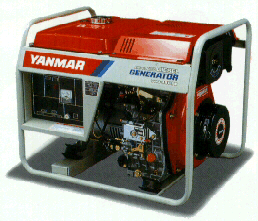
Petrol/diesel Generators (Gensets) are widely available and can be purchased in almost any country in the world. Their prices have dropped dramatically over the past several years, and the range of sizes for gensets has also increased markedly. They are easy to install and set up, however, their fuel and maintenance costs over time are high. Gensets are available for petrol (gasoline) or diesel fuels.
- Petrol gensets are most suitable for smaller applications [power ranges generally from as low as 250W to several kilowatts] such as small lighting systems, pumps, or small, short-use audiovisuals. Petrol/gasoline gensets are more expensive to operate than diesel gensets.
- Diesel gensets are more appropriate for larger power requirements [from as low as 3 kVA up to as much as 10 MW, with gensets of 100-750 kVA not at all uncommon as back-up generators for industries, hotels, camps, hospitals, etc.] with longer running times. Institutions should consider diesel gensets for wide lighting and power needs. Diesels are noisy and smokey, which may necessitate locating them away from point of electricity use.
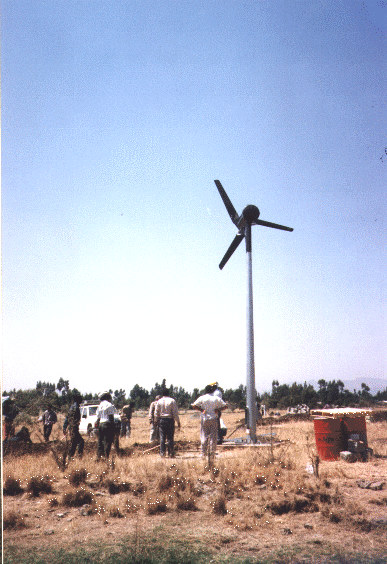
Wind generator technology has improved markedly in the past few years, and reliable machines are now available rated at 100W and up. Wind generators can be considered where mean wind speeds are higher than 4-5 m/s (suppliers can help assess wind resources). Wind turbines require well-constructed towers, control systems, and backup battery storage.
Hydropower systems have been used for many decades, and are usually the most economic power source in situations when there is a year-round source of fast-moving water near the site. Proven technologies are available between 500 W and several thousands of kilowatts. Hydropower requires a relatively high level of civil works.
Mechanical hydropower systems can also be used for pumping water (hydro-rams).
Hybrid System: You can combine two or more of the above technologies to make a more versatile system, commonly referred to as a “hybrid” system. For example, solar PV can be combined with a genset to run all the loads in a small institution.
The PV system can run lighting loads, while the generator can be used to run heavier loads (pumps, x-ray, etc) and to charge batteries when there is not enough sunshine. The same hybrid solution is often adopted for isolated rural wind generator systems.
Decision 5: How will your systems be configured?
When choosing, you will need to decide on the type of electrical system you want. It can be as basic as a lead-acid battery, or it may include a range of components to power several 240VAC appliances.
This decision should take into account the compatibility of energy supply components (e.g., a 12VDC lighting system cannot power a 240VAC color TV). You also need to consider how reliable you want your electricity supply to be (e.g., vaccine refrigeration or operation theater lighting requires 100% reliability and is worthy of extra expense). These issues are discussed below.
Do you require batteries? Rechargeable batteries store power from the generating source for use when power is not available. Most rechargeable batteries available are either lead-acid or nickel cadmium based.
When choosing batteries for large-scale uses, refrigeration, and audio-visual power systems, it is important that high-quality, deep-discharge batteries are chosen. For small-scale lighting systems, locally-made batteries may be appropriate. Remember, batteries need to be replaced at regular intervals, and have critical maintenance needs.
- PV and wind systems usually require battery storage for lighting, audio-visual and refrigeration systems. Pumping systems can store pumped water in tanks and avoid the need for batteries.
- Gensets can cost-effectively use electric power to charge batteries, and to run small loads from batteries (rather than running gensets 24 hours). Such systems require an inverter/battery charger to convert DC power to AC.
What voltage will your equipment operate at (12V DC or 120/240VAC)? PV systems, and most RET systems, produce power at 12VDC. Generators produce electricity at 110/120-220/240VAC. The choice of appliances will depend on system voltage. Although 240VAC appliances are by far the most common, in many cases 12VDC appliances are more practical because they are more simple and more efficient.
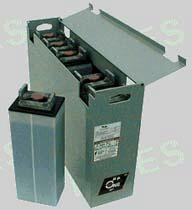
Do you require inverters? Inverters are used to change low voltage dc power (i.e. from batteries) to high voltage ac power (e.g., to power computers). If you are storing power in batteries, and you are using 240/120V appliances, you will need to use an inverter. Inverters increase system complexity and lower system efficiency.
Decision 6: What energy system fits within your budget?
The supply option you choose will depend on the funds you have available for purchasing. Usually, PV and RET devices have high up-front fuel costs, while generator sets have lower up-front costs and higher running costs.
While it is difficult to compare the costs of one energy source to another, there are some general indicators that give an idea of the cost for delivered energy (e.g., energy in electricity equivalent terms, i.e., kilowatt hours). Table 2 presents first order comparisons between various power sources.
Table 2: Illustrative Comparison of Costs for Energy from Different Energy Sources
| Energy Source | Availability | Low cost (US$/kWh) | High cost (US$/kWh) |
| Fuels | |||
| Candle | Very good | 0.10 | 0.20 |
| Kerosene (paraffin) | Good | 0.40 | 1.20 |
| LPG | Poor | 0.20 | 1.00 |
| Electricity Sources | |||
| Dry cell battery | Very good | 5.00 | 400.00 |
| Nickel-cadmium rechargeable battery | Poor | 12.00 | 35.00 |
| Recharged lead-acid battery | Very good | 1.50 | 4.50 |
| Photovoltaic system | Medium | 0.40 | 3.50 |
| Petrol (gasoline)engine | Medium | 0.50 | 2.00 |
| Diesel engine | Medium | 0.30 | 1.20 |
| Wind generator (< 1 kVA) | Poor | 0.60 | 2.00 |
| Wind generator (> 1 kVA) | Poor | 0.40 | 1.60 |
| Micro-hydroelectric | Poor | 0.20 | 2.50 |
These costs are illustrative and can vary significantly from one place to the next.
Micro-hydroelectric, for example, can be very inexpensive if the civil works are already in place, or can be very expensive if the site must be developed from scratch. The cost of fuels like kerosene and LPG is relatively low, but end-use equipment (e.g., refrigerators) can be very expensive.
Decision 6: What are your organizational goals, capabilities and requirements?
A final consideration in the choice of energy system is the organizational abilities and desires of the group buying the system. Complex systems and technologies require more management than simple ones, so maintenance should always be at the center of purchasing plans.
- What is the infrastructure like where you plan to install your technology (e.g., has the technology already been introduced in your area)? Introducing new technologies is a long process, and there is always the risk that the technology will become an “orphan” if it is not maintained.
- What is the human capacity where you are (e.g., technical skills, operational skills, etc.)? No energy system is completely maintenance-free. You will need to find out whether the technology requires special training or maintenance abilities, and put these in place when installing
Is sustainability and technology development a major objective of your organization? For an organization like a hospital, functionality is a far higher priority than technology development, and therefore the most simple and workable solution makes the most sense.
For development organizations, introduction to the community of environmentally-sustainable technologies (e.g., a wind generator) might be of high priority, as the organization has time to follow up on the issues related to infrastructure-building.




